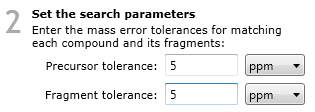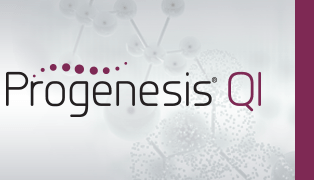Support for NIST MS/MS Library
For details of pricing and how to purchase this compound search method, please contact us.
About this plug-in
The NIST library search plugin bundles the NIST MS/MS libraries and performs a combination of neutral mass and MS/MS based searches. It uses the same search and scoring algorithms as Progenesis MetaScope.
Set the search parameters
Searches using the NIST library search plugin require the selection of two search parameters:

The NIST parameter selection options.
- Precursor tolerance
-
This value, in ppm or Da, is the maximum difference between the mass for the compound in the NIST library and the observed mass.
Where a compound has been successfully deconvoluted, the neutral mass is searched directly against the neutral mass in the NIST library.
Where only a single m/z is available, and its adduct status is unclear, a single neutral mass cannot be assigned for searching against the NIST library. Instead, this compound will be searched multiple times. Each time, it is treated as if it is derived from a different adduct; the neutral mass corresponding to that original m/z and assumed adduct is calculated and searched, and this is repeated for all the adducts you defined in the experiment setup that could impart the correct observed charge state for the compound. This allows attempted identification even for compounds without a known neutral mass.
- Fragment tolerance
-
This threshold (in ppm or Da) is the maximum difference between the mass of a fragment in the NIST MS/MS library and the observed mass of the fragment.
The NIST libraries contain MS/MS data for many commonly adducted forms of compounds. Progenesis QI will search only for fragments that are derived from the adducted precursors it has determined are present for that compound, to reduce false positives (hits against fragments that would not be present as the precursor for them is not present).
Search for identifications
Clicking this button will begin the search, and automatically import the results against your compounds at the Possible identifications window at the Identify Compounds screen.
You can visualise the matching of measured to database-predicted fragments for each potential ID using the 'mirror plot' on the same screen, after clicking on a search result. Matched fragments are shown in red, unmatched in grey; and hovering the cursor over a fragment match will display relevant information in a tooltip.

Fragment matching for NIST results can be visualised in a mirror plot above the Possible identifications table.





